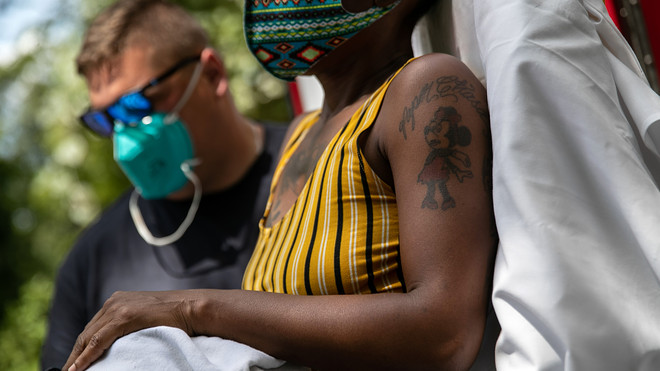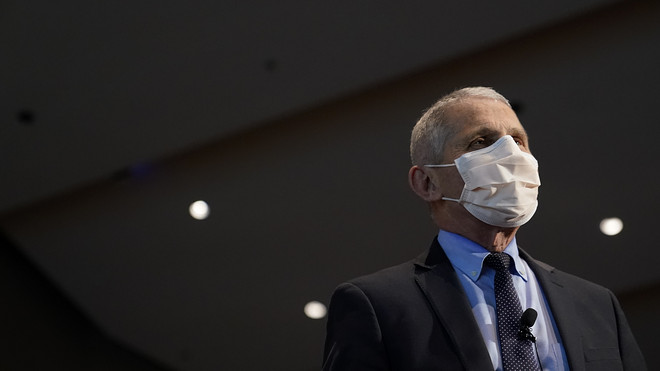
A woman suffering from probable COVID-19 symptoms is transported to a hospital in Houston, Texas last August. Medics with the Houston Fire Department wear protective masks on all medical calls, whether patients have been tested for COVID-19 or not.
John Moore/Getty Images
Texas Gov. Greg Abbott, a Republican, officially ended his state’s public face-mask mandate Wednesday, and allowed businesses to reopen, despite opposition. Gilberto Hinojosa, chairman of the Texas Democratic Party, described the move as “extraordinarily dangerous” and said it “will kill Texans.”
Health professionals have decried moves to go maskless. Barbara Alexander, president of Infectious Diseases Society of America, had three words for people: “Mask up, America!” “Reports indicating that these reductions have stalled should remind us that our progress is fragile,” she said, referring to declining rates of coronavirus infections.
“ ‘COVID-19 continues to spread and take lives. Emerging and more transmissible variants of the virus pose new and increased risks.’ ”
“Only around 10% of Americans nationwide have been vaccinated (33 million people) and many of the people at greatest risk have yet to receive a vaccine. COVID-19 continues to spread and take lives. Emerging and more transmissible variants of the virus pose new and increased risks,” she said.
Austin, the fourth largest city in Texas, will require masks, despite the state orders. As of Thursday, the number of deaths from COVID-19 in the U.S. continues to climb, and recently surpassed 529,203. Texas has the third-highest number of COVID-related deaths (45,795) in the country after California (54,820) and New York (48,573).
Maintaining social distance, avoiding large gatherings, frequent hand-washing and mask-wearing should continue, Alexander said. “Abandoning them now will postpone the day we can put COVID-19 behind us. We can’t forget the lessons this pandemic has taught us, or its terrible toll.”
The only Americans who should forego masks are those who have already been fully vaccinated and they should only do so among other vaccinated people, according to guidance how fully vaccinated people can socialize released this week by the U.S. Centers for Disease Control and Prevention.
In a recent study in the Journal of Adolescent Health study, Indiana University researchers said even most high-school age youths are willing to wear face masks to help stop the spread of COVID-19, though they called for more education on how to wear masks properly, and more consistently.

A review of literature on face masks published in January by the peer-reviewed Proceedings of the National Academy of Sciences, the official journal of the National Academy of Sciences, concluded: “Public mask wearing is most effective at reducing spread of the virus when compliance is high.”
“The preponderance of evidence indicates that mask wearing reduces transmissibility per contact by reducing transmission of infected respiratory particles in both laboratory and clinical contexts,” the 19 international authors of the review concluded.
COVID-19 is known to be transmissible among pre-symptomatic and asymptomatic individuals, and those presenting few symptoms. “We recommend that public officials and governments strongly encourage the use of widespread face masks in public,” they wrote.
“ ‘Public mask wearing is most effective at reducing spread of the virus when compliance is high.’ ”
Face masks likely played a role in reducing the spread of SARS-CoV-2 in Italy during the first half of 2020, and could have reduced the number of official COVID-19 cases there by up to 30,000 during the surge in cases during the spring of 2020, research in the peer-reviewed journal Infectious Diseases found.
Morten Gram Pedersen, lead author of the study and associate professor at the Department of Information Engineering of the University of Padova, wrote in the study, “We did not see this reduction in places that did not introduce any additional local interventions at that time.”
Many previous studies have said that face masks have helped reduce contagion by reducing droplets being sprayed into the air. It may be that masks also help promote healthy behaviors, and encourage people not to touch their faces during or after they are in public settings.
This study says N95 medical-grade masks help filter viruses larger than 0.1 micrometers (One micrometer is one millionth of a meter). The coronavirus is 0.125 micrometers. These products “have been shown to have efficacy at filtering smaller particles and are designed to fit tightly to the face.”

Dr. Anthony Fauci, director of the National Institute of Allergy and Infectious Diseases.
Getty Images
When asked last month whether Americans will still be wearing masks in 2022 and when life will return to normal, Anthony Fauci, the director of the National Institute of Allergy and Infectious Diseases, told CNN. “It is possible that that’s the case, and again it really depends on what you mean by normality.”
“If normality means exactly the way things were before we had this happen to us, I mean, I can’t predict that,” he said. “Obviously, I think we’re going to have a significant degree of normality beyond what a terrible burden all of us have been through over the last year.”
But he warned that the new, more contagious versions of the COVID-19 virus will also determine whether people will still be wearing masks in 2022. “There are so many other things that would make a projection that I give you today on this Sunday wind up not being the case six months from now.”
“ ‘I think we’re going to have a significant degree of normality beyond what a terrible burden all of us have been through over the last year.’ ”
Fauci has said that if 70% to 85% of the U.S. population was vaccinated, that would equate to good “herd immunity,” and the country should start to see a return to normalcy by the fall. That, of course, may depend on individuals’ age, circumstances and underlying conditions.
In January, U.S. President Joe Biden signed a mask mandate for all federal workers and anyone on federal property. They should, the mandate said, “all wear masks, maintain physical distance, and adhere to other public-health measures, as provided in CDC guidelines.”
Pfizer PFE, +1.39% and German partner BioNTech SE’s BNTX, +1.60% and Moderna’s MRNA, -0.86% mRNA-based two-shot vaccines are about 95% effective. J&J vaccine is an adenovirus vector-based vaccine, and it only requires one shot in the U.S. It has 72% efficacy.
Despite reluctance by some Americans to get the J&J vaccine, even though people are not given a choice, all three vaccines can prevent severe disease, hospitalization and death. “Each of them are very effective in preventing clinically apparent disease,” Fauci said on Friday.








